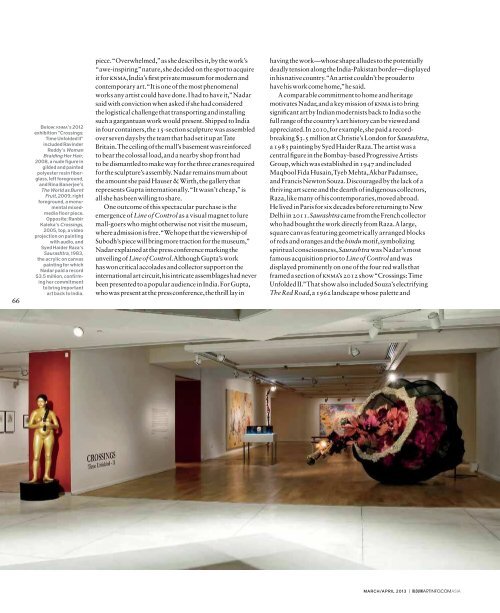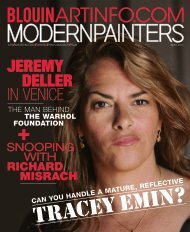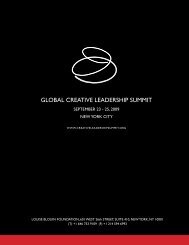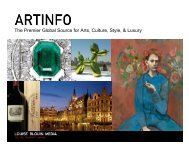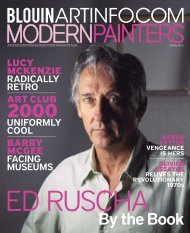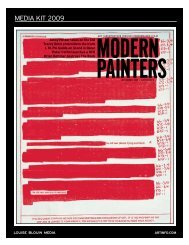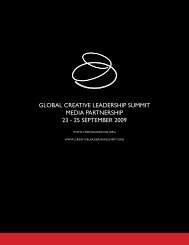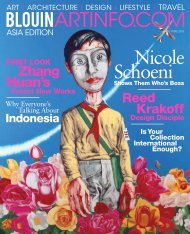Linke - Artinfo
Linke - Artinfo
Linke - Artinfo
Create successful ePaper yourself
Turn your PDF publications into a flip-book with our unique Google optimized e-Paper software.
66<br />
Below: knma’s 2012<br />
exhibition “Crossings:<br />
Time Unfolded II”<br />
included Ravinder<br />
Reddy’s Woman<br />
Braiding Her Hair,<br />
2008, a nude figure in<br />
gilded and painted<br />
polyester resin fiberglass,<br />
left foreground,<br />
and Rina Banerjee’s<br />
The World as Burnt<br />
Fruit, 2009, right<br />
foreground, a monumental<br />
mixed-<br />
media floor piece.<br />
Opposite: Ranbir<br />
kaleka’s Crossings,<br />
2005, top, a video<br />
projection on painting<br />
with audio, and<br />
Syed Haider Raza’s<br />
Saurashtra, 1983,<br />
the acrylic on canvas<br />
painting for which<br />
nadar paid a record<br />
$3.5 million, confirming<br />
her commitment<br />
to bring important<br />
art back to India.<br />
piece. “Overwhelmed,” as she describes it, by the work’s<br />
“awe-inspiring” nature, she decided on the spot to acquire<br />
it for knma, India’s first private museum for modern and<br />
contemporary art. “It is one of the most phenomenal<br />
works any artist could have done. I had to have it,” Nadar<br />
said with conviction when asked if she had considered<br />
the logistical challenge that transporting and installing<br />
such a gargantuan work would present. Shipped to India<br />
in four containers, the 15-section sculpture was assembled<br />
over seven days by the team that had set it up at Tate<br />
Britain. The ceiling of the mall’s basement was reinforced<br />
to bear the colossal load, and a nearby shop front had<br />
to be dismantled to make way for the three cranes required<br />
for the sculpture’s assembly. Nadar remains mum about<br />
the amount she paid Hauser & Wirth, the gallery that<br />
represents Gupta internationally. “It wasn’t cheap,” is<br />
all she has been willing to share.<br />
One outcome of this spectacular purchase is the<br />
emergence of Line of Control as a visual magnet to lure<br />
mall-goers who might otherwise not visit the museum,<br />
where admission is free. “We hope that the viewership of<br />
Subodh’s piece will bring more traction for the museum,”<br />
Nadar explained at the press conference marking the<br />
unveiling of Line of Control. Although Gupta’s work<br />
has won critical accolades and collector support on the<br />
international art circuit, his intricate assemblages had never<br />
been presented to a popular audience in India. For Gupta,<br />
who was present at the press conference, the thrill lay in<br />
having the work—whose shape alludes to the potentially<br />
deadly tension along the India-Pakistan border—displayed<br />
in his native country. “An artist couldn’t be prouder to<br />
have his work come home,” he said.<br />
A comparable commitment to home and heritage<br />
motivates Nadar, and a key mission of knma is to bring<br />
significant art by Indian modernists back to India so the<br />
full range of the country’s art history can be viewed and<br />
appreciated. In 2010, for example, she paid a recordbreaking<br />
$3.5 million at Christie’s London for Saurashtra,<br />
a 1983 painting by Syed Haider Raza. The artist was a<br />
central figure in the Bombay-based Progressive Artists<br />
Group, which was established in 1947 and included<br />
Maqbool Fida Husain, Tyeb Mehta, Akbar Padamsee,<br />
and Francis Newton Souza. Discouraged by the lack of a<br />
thriving art scene and the dearth of indigenous collectors,<br />
Raza, like many of his contemporaries, moved abroad.<br />
He lived in Paris for six decades before returning to New<br />
Delhi in 2011. Saurashtra came from the French collector<br />
who had bought the work directly from Raza. A large,<br />
square canvas featuring geometrically arranged blocks<br />
of reds and oranges and the bindu motif, symbolizing<br />
spiritual consciousness, Saurashtra was Nadar’s most<br />
famous acquisition prior to Line of Control and was<br />
displayed prominently on one of the four red walls that<br />
framed a section of knma’s 2012 show “Crossings: Time<br />
Unfolded II.” That show also included Souza’s electrifying<br />
The Red Road, a 1962 landscape whose palette and<br />
March/april 2013 | Blouin<strong>Artinfo</strong>.comAsiA<br />
this page and opposite: KnMa<br />
coarse texture are influenced by laterite, the rust-red soil<br />
of his birthplace, Goa, a coastal state south of Mumbai.<br />
Nadar’s pursuit of art isn’t limited to acquiring<br />
high-priced, high-profile works abroad, though several<br />
Indian art critics have grumbled, especially after she paid<br />
£993,250 ($1.5 million) at Sotheby’s London in 2010 for<br />
Bharti Kher’s The Skin Speaks a Language Not Its Own,<br />
2006, a life-size fiberglass elephant with Kher’s trademark<br />
bindis affixed across its surface. Her collecting is part of<br />
a larger philanthropic vision she shares with her husband,<br />
Shiv Nadar, who founded a technology start-up in 1976<br />
that has grown into the global behemoth HCL Enterprises.<br />
She began to acquire art in the late 1980s with the simple<br />
aim of decorating her walls. “I started collecting for our<br />
home, which we were building at the time. There was no<br />
thought of a museum,” she explains. “I commissioned<br />
art from Husain and bought works by Manjit Bawa and<br />
Rameshwar Broota; all three pieces are still in the house.”<br />
Nadar’s acquisitions budget—and her vision—grew<br />
with her husband’s success. The two met when Nadar<br />
was working for an advertising agency, and they soon<br />
became bridge partners. (She continues to play competitive<br />
bridge and has represented India in international<br />
tournaments.) HCL was flourishing, and Nadar, not<br />
content with being the idle wife of an entrepreneur,<br />
became instrumental in the company’s philanthropic<br />
and educational initiatives, which include the Shiv Nadar<br />
Foundation, established in 1996, and Shiv Nadar<br />
University, which had its first graduating class in 2011. She<br />
was on Forbes Asia magazine’s 48 Heroes of Philanthropy<br />
list in 2010; her husband followed one year later.<br />
By 2005 the Nadar home could no longer accommodate<br />
the collection, which had steadily grown, its focus no<br />
longer confined to Indian Progressive artists but expanded<br />
to embrace contemporary Indian lights like Atul Dodiya,<br />
Rina Banerjee, Ranbir Kaleka, and Anish Kapoor. “At<br />
some point I had a lot more art than I had wall space,<br />
and I had to decide whether to stop collecting or to keep<br />
putting works in storage,” Nadar says. “Keeping them<br />
in storage didn’t seem like a very wise thing, so I decided<br />
to do something more meaningful and set up a museum.<br />
And after I first had the thought, in 2006, it took me two<br />
or three years to plan it and get down to it.”<br />
“In late 2009 Mrs. Nadar and I started looking at<br />
all she had acquired since the late 1980s, so that the<br />
first step—to put the inventory in place—could begin,”<br />
recalls Roobina Karode, director and chief curator of the<br />
museum. knma opened in 2010, first in a location on<br />
the vast HCL campus in Noida. The inaugural exhibition,<br />
Blouin<strong>Artinfo</strong>.comAsiA | march/april 2013<br />
“building an<br />
iconic structure<br />
is as important<br />
for a museum<br />
as the art<br />
it houses.”<br />
67


